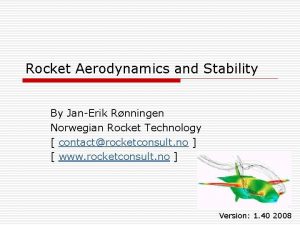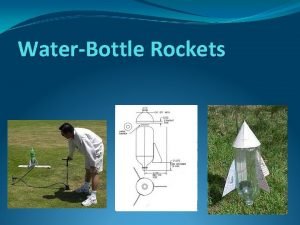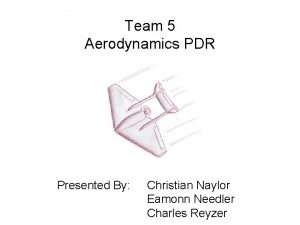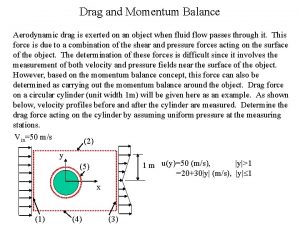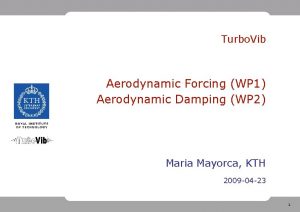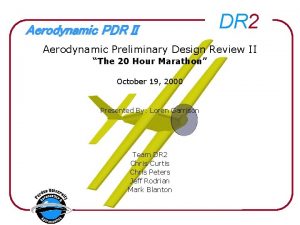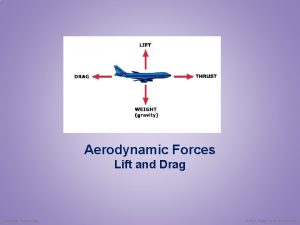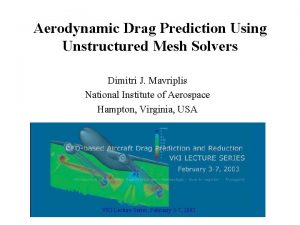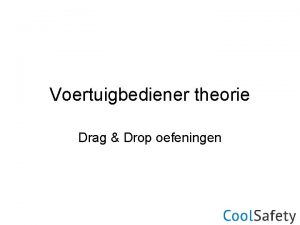MEASUREMENT OF THE AERODYNAMIC DRAG OF TEXTILES WITH
























- Slides: 24

MEASUREMENT OF THE AERODYNAMIC DRAG OF TEXTILES WITH A NOVEL DEVICE Schindelwig, K. 1, Hasler, M. 2, Nachbauer, W. 1, van Putten, J. 2, Knoflach, C. 2 1) Department of Sport Science, University of Innsbruck, Austria 2) Centre of Technology of Ski- and Alpine Sport

Introduction Aerodynamic is important for high speed sports speed skating, cycling, skiing… (Chowdhury et al. , 2010; Oggiano et al. 2009, D’Auteuil et al. 2010). Aerodynamic drag influenced through textiles e. g. surface roughness Drag measurement of textiles only with wind tunnel experiments (drawback - high costs) (Brownlie et al. , 2010, Chowdhury et al. , 2010) 18 th annual Congress of the EUROPEAN COLLEGE OF SPORT SCIENCE, 26 th – 29 th June 2013 2

Goal Aerodynamic drag measurement in a wide range of velocities Reliability of the novel measurement device Comparison Novel measurement device - Wind tunnel Influence of surface roughness smooth – rough surface textiles Influence of temperature -16°C to 16°C 18 th annual Congress of the EUROPEAN COLLEGE OF SPORT SCIENCE, 26 th – 29 th June 2013 3

Method: Novel linear measurement device high torque electro motor (80 k. W) i bea e c n da gu m 5 2 carriage m le b a c bre fi 18 th annual Congress of the EUROPEAN COLLEGE OF SPORT SCIENCE, 26 th – 29 th June 2013 6

Method: Data acquisition devices inductive length measurement system carriage Cylinder with textiles: 60 cm height 15 cm diameter 40 cm load cells 18 th annual Congress of the EUROPEAN COLLEGE OF SPORT SCIENCE, 26 th – 29 th June 2013 5

Method: Data acquisition devices 18 th annual Congress of the EUROPEAN COLLEGE OF SPORT SCIENCE, 26 th – 29 th June 2013 5

Method: Cooling chamber Temperature range from: -30°C to 30°C 18 th annual Congress of the EUROPEAN COLLEGE OF SPORT SCIENCE, 26 th – 29 th June 2013 7

Method: Smooth and Rough textiles 1 cm 18 th annual Congress of the EUROPEAN COLLEGE OF SPORT SCIENCE, 26 th – 29 th June 2013 8

Method Linear measurement system Both textiles 10 times at each speed 5 – 20 m/s; step size 1 m/s at -16°C and 16°C Aeroacustic wind tunnel (Audi, Ingolstadt, Germany) Both textiles 2 times at each speed 8. 3 – 38. 8 m/s; step size 2. 7 m/s at 24°C 18 th annual Congress of the EUROPEAN COLLEGE OF SPORT SCIENCE, 26 th – 29 th June 2013 9

Method: Calculation 18 th annual Congress of the EUROPEAN COLLEGE OF SPORT SCIENCE, 26 th – 29 th June 2013 9

Results: Velocity 25 measurement range v (m/s) 20 15 10 5 0 0 0, 5 1 1, 5 2 time (s) 2, 5 3 18 th annual Congress of the EUROPEAN COLLEGE OF SPORT SCIENCE, 26 th – 29 th June 2013 3, 5 10

Results: Forces at 5 m/s F (N) 20 Fa Fm 0 FD (N) -20 20 0 -20 0 1 2 time (s) 3

Results: Range of 10 trials CD 1, 2 0, 0 5 6 7 8 9 10 11 12 13 14 15 16 17 18 19 20 v (m/s) 18 th annual Congress of the EUROPEAN COLLEGE OF SPORT SCIENCE, 26 th – 29 th June 2013 10

Results: wind tunnel – novel m. d. CD 0, 8 0, 2 1 2 3 4 5 6 7 8 9 10 11 12 13 14 15 16 v (m/s) 18 th annual Congress of the EUROPEAN COLLEGE OF SPORT SCIENCE, 26 th – 29 th June 2013 10

Results: temperature 0, 8 c. D -16°C 0, 2 5 10 15 20 v (m/s) -16°C c. D 0, 8 0, 2 50 000 100 000 150 000 200 000 Re ( ) 18 th annual Congress of the EUROPEAN COLLEGE OF SPORT SCIENCE, 26 th – 29 th June 2013 11

Results: summary Reliability novel linearmeasurement device mean range 10 measurements +/- 2. 4%. wind tunnel mean range 10 measurements +/- 10%. Comparison good agreement wind tunnel – novel measurement system mean difference 6% Influence of surface roughness same as in literature (smooth surface - rough surface) Influence of temperature smooth surface higher than rough surface 18 th annual Congress of the EUROPEAN COLLEGE OF SPORT SCIENCE, 26 th – 29 th June 2013 10

Conclusion With the novel linear measurement system we have developed a accuracy possibility to determine the drag of textiles from speeds between 5 to 20 m/s and the great advantage is that the costs are low. In future we also want to determine the lift with the novel linear measurement system on the cylinder with different angle of attack. 18 th annual Congress of the EUROPEAN COLLEGE OF SPORT SCIENCE, 26 th – 29 th June 2013 10

Method: Calculation 18 th annual Congress of the EUROPEAN COLLEGE OF SPORT SCIENCE, 26 th – 29 th June 2013 9

Results The circular cylinder is one of the most common bluff body shapes with round edges. Cylinder aerodynamics has received a lot of attention from researchers for decades, yet remains inadequately understood. The three main aerodynamic regimes as denoted by where the transition from laminar to turbulent flow occurs have been described in detail in Zdravkovich [1]. At low Reynolds number, the transition happens in the wake, Tr. W, then the transition moves forward to the shear layer, Tr. SL, and by increasing the Reynolds number up to 1 x 10 5, the transition takesplace in the boundary layer, Tr. BL, where an important reduction of the drag is observed which defines the critical Reynolds number range for a circular cylinder. The left side of Figure 1 shows the aerodynamic force coefficients and especially the drag coefficient (C D ) as a function of Reynolds number for a smooth circular cylinder with the three distinct regimes and the important drag reduction in the Tr. BL regime. 18 th annual Congress of the EUROPEAN COLLEGE OF SPORT SCIENCE, 26 th – 29 th June 2013 10

Results 18 th annual Congress of the EUROPEAN COLLEGE OF SPORT SCIENCE, 26 th – 29 th June 2013 10

Results 18 th annual Congress of the EUROPEAN COLLEGE OF SPORT SCIENCE, 26 th – 29 th June 2013 10

Results The friction drag results from the friction between the air and the athlete and is represented by a viscous boundary layer at the surface of the athlete's garment. The pressure drag results from the difference in pressure between the windward and leeward area of the athlete along the direction of the flow. When separation of the shear layer occurs, pressure drag dominates over friction drag which defines the ‘bluff body’ aerodynamics category. 18 th annual Congress of the EUROPEAN COLLEGE OF SPORT SCIENCE, 26 th – 29 th June 2013 10

Results The friction drag results from the friction between the air and the athlete and is represented by a viscous boundary layer at the surface of the athlete's garment. The pressure drag results from the difference in pressure between the windward and leeward area of the athlete along the direction of the flow. When separation of the shear layer occurs, pressure drag dominates over friction drag which defines the ‘bluff body’ aerodynamics category. 18 th annual Congress of the EUROPEAN COLLEGE OF SPORT SCIENCE, 26 th – 29 th June 2013 10

Method: Sensors Linear measurement system Position measurement Device (LMB-130. 2, LMK 132 -Z-1. 6. 0 AMO, Austria) Resolution: 0. 01 mm distance date smoothed with a quintic spline (0. 001) Force measurement Device (HBM Wägemesszelle…) Range Aeroacustic wind tunnel (Audi, Ingolstadt, Germany) Force measurement with a internal force plate 18 th annual Congress of the EUROPEAN COLLEGE OF SPORT SCIENCE, 26 th – 29 th June 2013 9
 Cl formula aerodynamics
Cl formula aerodynamics Aerodynamics of rockets
Aerodynamics of rockets Least aerodynamic shape
Least aerodynamic shape Co2 dragster aerodynamics
Co2 dragster aerodynamics Bottle rocket fins design
Bottle rocket fins design Aerodynamic shapes
Aerodynamic shapes Christian naylor
Christian naylor Aerodynamic devices
Aerodynamic devices Fastenings textiles
Fastenings textiles Health and safety in textiles classroom
Health and safety in textiles classroom Textiles gran fe
Textiles gran fe Difference between modern and smart materials
Difference between modern and smart materials Alabanza la armadura de dios con letra
Alabanza la armadura de dios con letra Weave patterns of fibers forensics
Weave patterns of fibers forensics Transversal y longitudinal corte
Transversal y longitudinal corte Safety rules in textiles classroom
Safety rules in textiles classroom Adnan textile
Adnan textile What is textile?
What is textile? Jefe de almacen organigrama
Jefe de almacen organigrama What is the primary site factor for production of textiles?
What is the primary site factor for production of textiles? Health and safety in textiles classroom
Health and safety in textiles classroom Introduction to home textiles
Introduction to home textiles Clothing importer
Clothing importer Fashion and textile technologies
Fashion and textile technologies Polmeros
Polmeros

